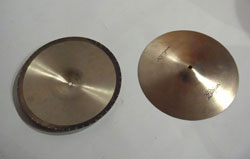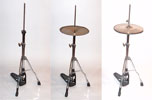
 : : : drumset : : Instruments : the hi-hat cymbals"
: : : drumset : : Instruments : the hi-hat cymbals"
The hi-hat cymbals

The hi-hat ("pedal" or "cymbal" or "pair of cymbals"), called "charleston" in French, may come from the town of the same name in South Carolina, with high afro-american population, in 1920 (the first jazz drummers at early twentieth century, such as Warren "Baby" Dodds , do not have it, and the two pedals "low boy" (low first invented) and "hi-hat" (contraction of "High-Hat"), as we know it today, were present for the first time in a catalog of instruments (brand Ludwig) in 1928 (which says nothing about the real date of invention, but at least marks the beginning of its development by its industrialization and commercialization)). Anyway the charleston is also the name of a dance appeared at the same time and associated with the same music (popularized by Josephine Baker in Paris). It is now inconceivable to think an even minimal modern drumset without the hi-hat (or "foot cymbal"), which first involves the fourth limb of the drummer: the left foot (for a right-handed ).
The functioning of the hi-hat pedal is modeled on the bass drum pedal (invented 20 years earlier), but instead of hitting the instrument with a bat (or "beater" for drumset pedal), we come back on the original method of cymbals playing: one cymbal striking another of the same size, in opposition, on the edge.

The difference and the genius of this invention is to have arranged them horizontally to use the force of gravity, instead of vertically with the hands in marching bands, in Europe (although in Turkey, the Janissaries riders (at the origin of military musical using of the cymbals) also beat them in a vertical move by putting them horizontally (old miniatures shown that)).
By pressing the pedal, you operate a rod which slides in a vertical tube standing by a tripod (or more recently a bipod), on which is fixed the upper ("top") cymbal. The lower ("bottom") cymbal is simply placed on a plate felted and pierced to let the rod pass. A spring ensures the lifting of the rod (to keep the hi-hat closed, you must keep a constant pressure with the foot).
Hi-Hat pedals go therefore by pair but the lower cymbal ("bottom", not to be confused with the above, "top"), is thicker (to support the weight and enhance the overall timbre).
Their standard diameter is now 14'' (which corresponds to the smallest orchestral and military model, which goes up to 22'') but there are models of 15, 13, 12 and even 10'' (rarer).
Some drummers use a smaller upper cymbal to dry the sound of "chick" (stroke by foot pressure, "crushed" (muffled)), but it makes the play with drumsticks more difficult.
Recent models of bottom hi-hat cymbals are pierced near the dome or crenellated on the edge (like the model I use), which creates a pressure relief vent (as it exists on all drum shells). This gives the effect of a cleaner foot playing and a dryer and more controllable "chick". On the opposite, you lose a little control of hands and foot crash.
Some drummers use two different manufacturing models for their Hi-hat (like Steve Gadd , for example), which has the effect to enrich the timbre and give more crash quality, or to obtain a compromise between two types of cymbals (Steve Gadd is a specialist of "jazz-rock", and thus he gains in versatility with this composite set (half "jazz" (cymbal richer and more chaotic), half "rock" (cymbal with purer and more regular sound)); his set of hi-hat is recently marketed by the manufacturer Zildjian ("K/Z" model) which avoids to buy two pairs of hi-hat to constitute it).
You can buy stands without hi-hat pedal, where the cymbals pressure is adjustable by a wingnut to isolate the playing with the left foot (on double pedal for example) from the hands (Dave Weckl , Dennis Chambers , Terry Bozzio , Mike Terrana , Virgil Donati and many others, have systematized its use in 1980 and 1990).
Recently is appeared the invention of the "remote" hi-hat pedal with flexible cable (rather than tube and stand), which is useful for alternate hitting of the left foot and hits on the right side, or operate a hi-hat with right foot (Terry Bozzio uses this kind of hi-hat, one on the left with cymbals above the right foot bass drum, allowing him to extend its toms row continuously far to the left, and one hi-hat to the right to play double hi-hat (with the two feet)).
The hi-hat pedal is traditionally played with the left foot (for a right hander). It is located to the left of the snare (which is between the legs), symmetrically to the bass drum (when using a bass drum double pedal or a second bass drum, it is generally placed to the left of the left pedal).
One caracteristic that makes the hi-hat cymbals playing so typical of modern drumset, and which is unique compared to all other instruments of the drum set, is the ability to play at the same time with the foot and hands (Max Roach , one of the few jazz drummers to make entire solo performances, played solos entirely and only with a hi-hat pedal, which he put then in front of the scene to accentuate the effect).
This caracteristic allows 6 distinct and recognizable basic strokes:
- 1: The "chick" (Zildjian Avedis Mastersound 14" hi-hat here):
- Foot pressure, maintaining the pressure just after to muffle the sound (used in syncope to make the "chabada" inseparable from jazz ("di - - chi - ti"), which is originally played on the hi-hat). A "trick" to make fast "chicks" (and therefore with almost immediate lifting of the foot required) is to play heel up (the extreme pressure caused by the weight of the leg, causing a crush with enough muffling). This is a technique that was widely used by John Bonham (Led Zeppelin) and Tony Williams (Miles Davis) in their breaks ("fills") and solos (eighth notes or quarter notes beats with the left foot) to give the illusion of playing with two drummers. This technique has been pushed to the extreme by Jack de Johnette , which varies off-beats and on-beats, with remarkable ease, which allows him to improvise with the four limbs at the same time.
- 2: The "crash" with the foot:
- Resonant hit by lifting the foot immediatly after he did clash the cymbals. To do this, it is easier to lay the heel down on the ground. Steve Gadd and Al Foster have developed in the 1970s a technique that consists of alternating "crash" and "chick" of the hi-hat (in a "rocking" heel-toe playing) in a continuous flow and independence. Vinnie Colaiuta , in the 1980s, is also a master in this discipline by playing heel toe in independence with both feet (a technical summit hardly to surpass).
- 3: The "ping" with close hi-hat:
- Stroke of stick tip on top cymbal, by putting a constant pressure with the foot. This stroke, typical of rock style, is traditionally played with eighth notes with the right hand, crossing arms over the left hand, which plays on the snare. In jazz samba, modern drummers play often sixteenth notes in continuous flow, sometimes with accents, with one or two hands (with single stroke roll), to mimic a "ganza", a "chocalho" or "pandeiro".
- 4: The shaft stroke on edge of close hi-hat:
- Powerful and dry sound ideal for creating accents with "hits alternating" (hitting with the arm here and with the wrist in "ping" in a rocking motion ("Moeller technique"), often used in reggae by Sly Dunbar among others, or in blues and hard rock by Bernard Purdie , Jeff Porcaro , John Bonham , ...).
- 5: The "crash" with stick stroke, with open hi-hat:
- Stroke of the shaft on the edge, which make clash the two cymbals, foot up, popularized by the drummers of "trash metal" in the 1980s (like Lars Ulrich of Metallica but John Bonham is one of the initiators) with eighth note or quarter notes beats, in imitation of distorted electric guitars (careful the ears!). You can make a crescendo of hi-hat by gradually lifting the foot (without hitting stronger on the cymbals).
- 6: Crash with stick with immediate closing by the foot:
- Widely used in funk (by Clyde Stubblefield or Bernard Purdie for example), but also in jazz since the origins of the instrument (by Gene Krupa and Buddy Rich ) it is important to set the closure (mutting, "chick") in time and not to open too much here for a good "smooth" sound (cymbals must clash many times very quickly). This stroke is often accompanied by a kick drum or snare drum in unison to enhance the effect of hyper dry and powerful accent ("peach" or "punch" ("pêche" in French, pronounced "paish")) and played with the stick shaft on the cymbal edge in general (not necessary).
Marc De Douvan Dec. 2005, revised and translated in English in March 2013
© 2005 Marc de Douvan Crédits Mentions légales
